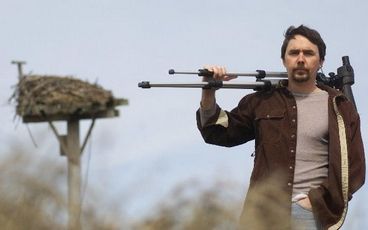Bad Advice Wednesday: Live on Osprey Time
categories: Cocktail Hour
5 comments
 Last week I wrote a column for OnEarth.org about learning patience through watching a great blue heron. As it turned out, that heron was just a warm up for another bird. A few years after I watched the heron, I set out to write a book about ospreys. As a kid on Cape Cod I had never seen the birds; they had been all but wiped out by DDT. When I moved back to Cape Cod as an adult I found that the birds had moved back too. I spent six months watching four nesting pairs of ospreys, spending several hours each day observing them in the way I’d watched the heron. I did this because I had come to love the birds—their enormous and sloppy nests, their daring dives, their flashing wings—but also for another more practical reason. I had sold a proposal for a book to a publisher about the birds and their comeback from DDT, and so watching ospreys became my daily work, my job, my sod-breaking.
Last week I wrote a column for OnEarth.org about learning patience through watching a great blue heron. As it turned out, that heron was just a warm up for another bird. A few years after I watched the heron, I set out to write a book about ospreys. As a kid on Cape Cod I had never seen the birds; they had been all but wiped out by DDT. When I moved back to Cape Cod as an adult I found that the birds had moved back too. I spent six months watching four nesting pairs of ospreys, spending several hours each day observing them in the way I’d watched the heron. I did this because I had come to love the birds—their enormous and sloppy nests, their daring dives, their flashing wings—but also for another more practical reason. I had sold a proposal for a book to a publisher about the birds and their comeback from DDT, and so watching ospreys became my daily work, my job, my sod-breaking.
But even though I was getting paid to do it, sitting still was not easy. “You’ve got to learn to live on osprey time,” said Alan Poole, the osprey expert who served as my adventure’s Obi Wan Kenobe. “It’s a good life the birds lead,” he added. “You’ve got to watch them do nothing. And they do a whole lot of nothing.”
In April of my osprey year I tried a small experiment at one of the nests. I stowed my watch, pens, tape recorder, and journal in my backpack, and hiked out near the nest, sitting on the bank above the creek. My goal was to see the place, and nothing but the place, and not let the mosquito-like hum of worry interfere. I hunkered low, out of the wind, and watched the nest. Two Canada Geese came in for a landing in the creek in their silly way, like awkward puppets held up by wires, and as I watched and thought–wanting desperately to grab a pen and write down the bit about “awkward puppets”–I realized just how ingrained was my need to scribble. For a short time my experiment seemed to work, until, after a while, the old sensation of uneasiness replaced that of peace. I got antsy and cold. I forced myself to sit still. I got up and sat back down. Finally, after a seemingly interminable period went by, I gave in. I walked over to my backpack, took out my watch, and stared at it. Seven minutes had passed.
But over the course of that year, I–gradually, grudgingly–got better at sitting still. And along with my new skill came rewards. At the beginning of my six months I couldn’t tell an osprey from a gull. By the end, after many hours of watching the birds fly, eat, raise their young and, yes, do a whole lot of nothing, I felt I had started to really know them. In fact, I later bragged to a friend, if a giant osprey was hurtling toward earth, and Bruce Willis had to assemble a group of experts to save the planet, I might be included on the team along with Alan Poole and the other scientists.
True, Bruce hasn’t called yet but it he does I’ll be ready. I am nothing if not patient.


I wanna go!! So Dave, does this mean there is a new osprey book in the works?
Not yet. Got a couple of projects first. Then Return to the Osprey.
Love the idea of learning to “do a whole lot of nothing”, Dave. Nice work!
That’s my goal over the next few days on Masonboro Island.
We have ice here if you run out!